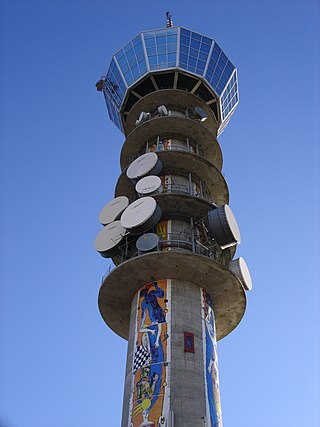
BBC Radio 4 is a British national radio station owned and operated by the BBC. The station replaced the BBC Home Service on 30 September 1967 and broadcasts a wide variety of spoken-word programmes from the BBC's headquarters at Broadcasting House, London. Since 2019, the station controller has been Mohit Bakaya. He replaced Gwyneth Williams, who had been the station controller since 2010.

AM broadcasting is radio broadcasting using amplitude modulation (AM) transmissions. It was the first method developed for making audio radio transmissions, and is still used worldwide, primarily for medium wave transmissions, but also on the longwave and shortwave radio bands.

Radio broadcasting is the broadcasting of audio (sound), sometimes with related metadata, by radio waves to radio receivers belonging to a public audience. In terrestrial radio broadcasting the radio waves are broadcast by a land-based radio station, while in satellite radio the radio waves are broadcast by a satellite in Earth orbit. To receive the content the listener must have a broadcast radio receiver (radio). Stations are often affiliated with a radio network that provides content in a common radio format, either in broadcast syndication or simulcast, or both. The encoding of a radio broadcast depends on whether it uses an analog or digital signal. Analog radio broadcasts use one of two types of radio wave modulation: amplitude modulation for AM radio, or frequency modulation for FM radio. Newer, digital radio stations transmit in several different digital audio standards, such as DAB, HD radio, or DRM.
RTÉ Radio 1 is an Irish national radio station owned and operated by RTÉ and is the direct descendant of Dublin radio station 2RN, which began broadcasting on a regular basis on 1 January 1926.

BBC Essex is the BBC's local radio station serving the county of Essex.

BBC Radio Solent is the BBC's local radio station serving Hampshire, Dorset and the Isle of Wight, broadcasting on FM, DAB, digital TV and via BBC Sounds from studios on Havelock Road in Southampton.

BBC Radio Derby is the BBC's local radio station serving Derbyshire and East Staffordshire.

BBC Radio Leeds is the BBC's local radio station serving the county of West Yorkshire.

BBC Radio Sheffield is the BBC's local radio station serving South Yorkshire, north Derbyshire and North Nottinghamshire.

Capital South Wales is a regional radio station owned by Communicorp UK and operated by Global as part of the Capital network. It broadcasts to Cardiff and Newport and the surrounding areas from studios in Cardiff Bay.
2NM is a local radio station in the Upper Hunter Valley of New South Wales, Australia. It is based in Muswellbrook and serves listeners in Muswellbrook, Singleton, Scone, Aberdeen, Merriwa, Murrurundi and surrounding areas.

BBC Radio Wales is a Welsh national radio station owned and operated by BBC Cymru Wales, a division of the BBC. It began broadcasting on 13 November 1978, replacing the Welsh opt-out service of BBC Radio 4.

FM broadcasting is a method of radio broadcasting that uses frequency modulation (FM) of the radio broadcast carrier wave. Invented in 1933 by American engineer Edwin Armstrong, wide-band FM is used worldwide to transmit high-fidelity sound over broadcast radio. FM broadcasting offers higher fidelity—more accurate reproduction of the original program sound—than other broadcasting techniques, such as AM broadcasting. It is also less susceptible to common forms of interference, having less static and popping sounds than are often heard on AM. Therefore, FM is used for most broadcasts of music and general audio. FM radio stations use the very high frequency range of radio frequencies.
Radio enjoys a huge following in the United Kingdom. There are around 600 licensed radio stations in the country. For a more comprehensive list see List of radio stations in the United Kingdom.
Marcher Radio Group Ltd, previously Marcher Sound Ltd, was a British media organisation which operated several radio stations in north Wales and northwest England. The company, now owned by Global Radio founded the independent local radio stations Marcher Sound, Coast 96.3, Buzz 97.1, Champion FM 103, and Wrexham and Chester Gold, part of the Gold Network.

NRK P1 is a nationwide digital radio channel operated by the Norwegian Broadcasting Corporation (NRK). It is the result of the NRK radio channel reform initiated in 1993 by radio director Tor Fuglevik.

BBC Radio Sussex is the BBC's local radio station serving the counties of East and West Sussex.

Hits Radio Liverpool, formerly Radio City, is an Independent Local Radio station based in Liverpool, England, owned and operated by Bauer Media Audio UK as part of the Hits Radio network. It broadcasts to Merseyside, Cheshire and parts of north Wales.
Radio Hafren was an Independent Local Radio station in the United Kingdom, serving Mid Wales and the English border counties and broadcasting on 756 AM and 102.1 FM. It was officially launched on Christmas Day 2010 after its bid to take over the licence of Radio Maldwyn was accepted on 15 December 2010, initially broadcasting on only 756 AM.
This is a timeline of the development of radio in Wales.












